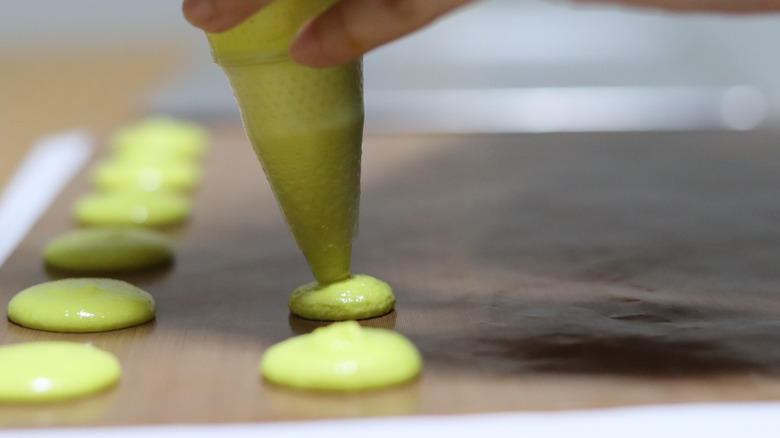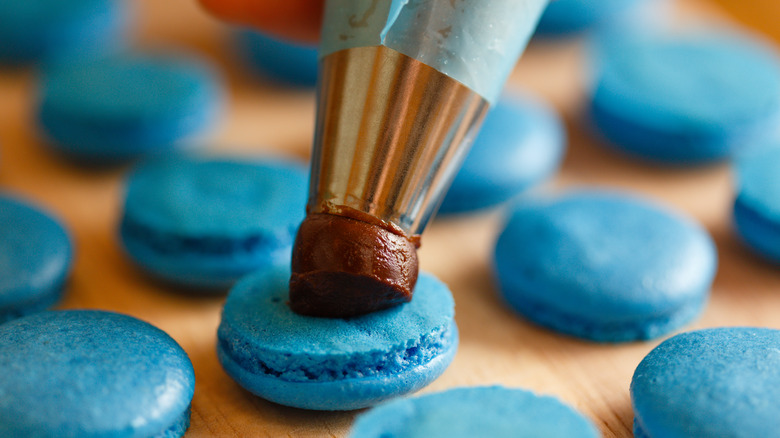Do You Need To Rest Macarons When Baking Them?
There's a reason macarons feel like an especially elegant and deserved treat. You may recognize the iconic French sandwich cookie, composed of a delicate yet nougat-like cookie shell, classically sandwiched with a variety of fillings, including buttercream frosting, caramel, jam, or even chocolate ganache. Even more tantalizing, macarons are particularly eye-catching and come in an array of vibrant colors to choose from in bakery cases.
Like many French bakes and pastries, precision is key to the macaron, which has been known to hold an elusive (and a bit of an exclusive) nature about it. Perhaps this comes from macarons' comparatively high cost due to their specialty ingredients, such as fine-ground almond flour. Many bakers are also intimidated by making macarons at home because of the specialized baking techniques used in making the prized cookie.
If you do try your hand at the particular yet rewarding macaron baking process, you may notice that one key step often stressed in cookbooks and baking blogs alike is to let your macarons rest before baking. This step may seem counter-intuitive, as many other cookie doughs and batters are quickly transferred to the oven to keep their cool temperature and form. While you might be tempted to speed up the already laborious macaron-making procedure and throw your colorful pink macaron cookie shells right in the oven after piping them onto your baking sheet, don't skip this step. Yes, you do need to let your macaron batter rest.
The resting step is key to a macaron's chewy, airy bite
The perfect French macaron is chewy, yet simultaneously light and delicate. When you bite into the cookie, there will be a crispy exterior on the shell, and the soft and airy inside melts in your mouth along with its silky filling.
The defined airiness of the macaron comes from its ingredients and specific baking methods. When bakers craft macaron batter, a silky smooth mixture of whipped eggs whites, granulated sugar, and cream of tartar (along with any colorings and flavors) are folded into a blend of almond flour and powdered sugar. The egg white mixture incorporates air into the batter and helps the macarons rise during baking.
Though it may seem like a small step, resting your cookie shells after piping them out onto a baking sheet is crucial. The resting process dries out the batter and helps form the skin (a protective surface layer to prevent air from escaping out the top of the cookie during baking), which is key to the cookie's smooth and domed shape. Due to the skin, any extra air can then be released via tiny pockets through the bottom of the cookie, forming the classic and desired aerated bubbly layer of height, or "feet," at the base of the macaron. Without letting the batter dry out, excess moisture will cause air to be released out the top of the cookie, leading to cracked and broken shells.
How to dry out your cookie shells
After you've folded the egg white mixture into the dry ingredients and have a smooth and aerated batter, pipe out your macarons into circles spaced one-inch apart onto a prepared baking tray (lined with wax paper or a silicon baking mat). Then, lift the tray a few inches and set it down against the counter with moderate force to remove any extra air bubbles hanging out on the surface of the batter.
Next, it's time to let your batter rest (and the perfect excuse to give yourself a breather, too). Let your cookies dry out for 30 to 45 minutes, or just until you notice a skin has formed and the surface of the cookies look duller in color. Depending on the humidity of your environment or if you added additional liquid flavorings and coloring to your batter, the shells may need to rest and dry out for a few minutes longer.
You can test out if your cookies are ready for the oven by carefully placing the tip of your finger on the surface of the macaron batter. If your finger doesn't stick, you're good to go. Transfer your macarons to the oven and bake for 12-14 minutes at 325 degrees Fahrenheit, cool, and then fill them. Thanks to the resting step, the surface of your cookies should come out smooth and domed, giving rise to a delectably airy cookie with a crisp outer shell.


